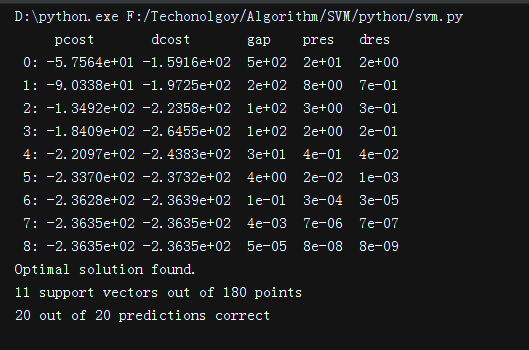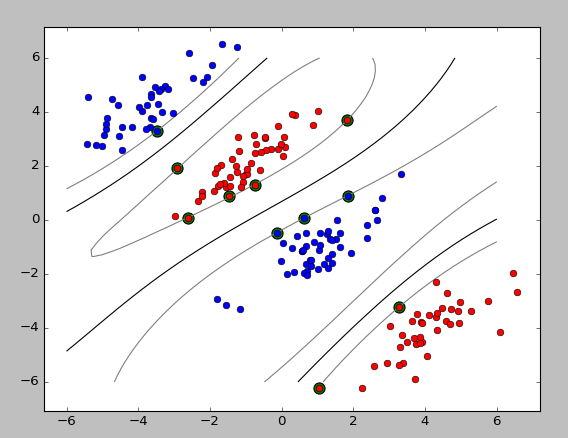支持向量机(SVM)——python3实现
今天看完soft-margin SVM就又搜了下相关的代码,最后搜到这个,第一次看懂了SVM的实现。
关于代码中cvxopt的使用,可以看下这个简单的介绍。
这里还是将代码贴在这里,里面加了自己的一下注释。
1 # -*- coding: utf-8 -*-
2 """
3 Created on Tue Nov 22 11:24:22 2016
4
5 @author: Administrator
6 """
7
8 # Mathieu Blondel, September 2010
9 # License: BSD 3 clause
10
11 import numpy as np
12 from numpy import linalg
13 import cvxopt
14 import cvxopt.solvers
15
16 def linear_kernel(x1, x2):
17 return np.dot(x1, x2)
18
19 def polynomial_kernel(x, y, p=3):
20 return (1 + np.dot(x, y)) ** p
21
22 def gaussian_kernel(x, y, sigma=5.0):
23 return np.exp(-linalg.norm(x-y)**2 / (2 * (sigma ** 2)))
24
25 class SVM(object):
26
27 def __init__(self, kernel=linear_kernel, C=None):
28 self.kernel = kernel
29 self.C = C
30 if self.C is not None: self.C = float(self.C)
31
32 def fit(self, X, y):
33 n_samples, n_features = X.shape
34
35 # Gram matrix
36 K = np.zeros((n_samples, n_samples))
37 for i in range(n_samples):
38 for j in range(n_samples):
39 K[i,j] = self.kernel(X[i], X[j])
40
41 P = cvxopt.matrix(np.outer(y,y) * K)
42 q = cvxopt.matrix(np.ones(n_samples) * -1)
43 A = cvxopt.matrix(y, (1,n_samples))
44 b = cvxopt.matrix(0.0)
45
46 if self.C is None:
47 G = cvxopt.matrix(np.diag(np.ones(n_samples) * -1))
48 h = cvxopt.matrix(np.zeros(n_samples))
49 else:
50 tmp1 = np.diag(np.ones(n_samples) * -1)
51 tmp2 = np.identity(n_samples)
52 G = cvxopt.matrix(np.vstack((tmp1, tmp2)))
53 tmp1 = np.zeros(n_samples)
54 tmp2 = np.ones(n_samples) * self.C
55 h = cvxopt.matrix(np.hstack((tmp1, tmp2)))
56
57 # solve QP problem
58 solution = cvxopt.solvers.qp(P, q, G, h, A, b)
59 # Lagrange multipliers
60 '''
61 数组的flatten和ravel方法将数组变为一个一维向量(铺平数组)。
62 flatten方法总是返回一个拷贝后的副本,
63 而ravel方法只有当有必要时才返回一个拷贝后的副本(所以该方法要快得多,尤其是在大数组上进行操作时)
64 '''
65 a = np.ravel(solution['x'])
66 # Support vectors have non zero lagrange multipliers
67 '''
68 这里a>1e-5就将其视为非零
69 '''
70 sv = a > 1e-5 # return a list with bool values
71 ind = np.arange(len(a))[sv] # sv's index
72 self.a = a[sv]
73 self.sv = X[sv] # sv's data
74 self.sv_y = y[sv] # sv's labels
75 print("%d support vectors out of %d points" % (len(self.a), n_samples))
76
77 # Intercept
78 '''
79 这里相当于对所有的支持向量求得的b取平均值
80 '''
81 self.b = 0
82 for n in range(len(self.a)):
83 self.b += self.sv_y[n]
84 self.b -= np.sum(self.a * self.sv_y * K[ind[n],sv])
85 self.b /= len(self.a)
86
87 # Weight vector
88 if self.kernel == linear_kernel:
89 self.w = np.zeros(n_features)
90 for n in range(len(self.a)):
91 # linear_kernel相当于在原空间,故计算w不用映射到feature space
92 self.w += self.a[n] * self.sv_y[n] * self.sv[n]
93 else:
94 self.w = None
95
96 def project(self, X):
97 # w有值,即kernel function 是 linear_kernel,直接计算即可
98 if self.w is not None:
99 return np.dot(X, self.w) + self.b
100 # w is None --> 不是linear_kernel,w要重新计算
101 # 这里没有去计算新的w(非线性情况不用计算w),直接用kernel matrix计算预测结果
102 else:
103 y_predict = np.zeros(len(X))
104 for i in range(len(X)):
105 s = 0
106 for a, sv_y, sv in zip(self.a, self.sv_y, self.sv):
107 s += a * sv_y * self.kernel(X[i], sv)
108 y_predict[i] = s
109 return y_predict + self.b
110
111 def predict(self, X):
112 return np.sign(self.project(X))
113
114 if __name__ == "__main__":
115 import pylab as pl
116
117 def gen_lin_separable_data():
118 # generate training data in the 2-d case
119 mean1 = np.array([0, 2])
120 mean2 = np.array([2, 0])
121 cov = np.array([[0.8, 0.6], [0.6, 0.8]])
122 X1 = np.random.multivariate_normal(mean1, cov, 100)
123 y1 = np.ones(len(X1))
124 X2 = np.random.multivariate_normal(mean2, cov, 100)
125 y2 = np.ones(len(X2)) * -1
126 return X1, y1, X2, y2
127
128 def gen_non_lin_separable_data():
129 mean1 = [-1, 2]
130 mean2 = [1, -1]
131 mean3 = [4, -4]
132 mean4 = [-4, 4]
133 cov = [[1.0,0.8], [0.8, 1.0]]
134 X1 = np.random.multivariate_normal(mean1, cov, 50)
135 X1 = np.vstack((X1, np.random.multivariate_normal(mean3, cov, 50)))
136 y1 = np.ones(len(X1))
137 X2 = np.random.multivariate_normal(mean2, cov, 50)
138 X2 = np.vstack((X2, np.random.multivariate_normal(mean4, cov, 50)))
139 y2 = np.ones(len(X2)) * -1
140 return X1, y1, X2, y2
141
142 def gen_lin_separable_overlap_data():
143 # generate training data in the 2-d case
144 mean1 = np.array([0, 2])
145 mean2 = np.array([2, 0])
146 cov = np.array([[1.5, 1.0], [1.0, 1.5]])
147 X1 = np.random.multivariate_normal(mean1, cov, 100)
148 y1 = np.ones(len(X1))
149 X2 = np.random.multivariate_normal(mean2, cov, 100)
150 y2 = np.ones(len(X2)) * -1
151 return X1, y1, X2, y2
152
153 def split_train(X1, y1, X2, y2):
154 X1_train = X1[:90]
155 y1_train = y1[:90]
156 X2_train = X2[:90]
157 y2_train = y2[:90]
158 X_train = np.vstack((X1_train, X2_train))
159 y_train = np.hstack((y1_train, y2_train))
160 return X_train, y_train
161
162 def split_test(X1, y1, X2, y2):
163 X1_test = X1[90:]
164 y1_test = y1[90:]
165 X2_test = X2[90:]
166 y2_test = y2[90:]
167 X_test = np.vstack((X1_test, X2_test))
168 y_test = np.hstack((y1_test, y2_test))
169 return X_test, y_test
170
171 # 仅仅在Linears使用此函数作图,即w存在时
172 def plot_margin(X1_train, X2_train, clf):
173 def f(x, w, b, c=0):
174 # given x, return y such that [x,y] in on the line
175 # w.x + b = c
176 return (-w[0] * x - b + c) / w[1]
177
178 pl.plot(X1_train[:,0], X1_train[:,1], "ro")
179 pl.plot(X2_train[:,0], X2_train[:,1], "bo")
180 pl.scatter(clf.sv[:,0], clf.sv[:,1], s=100, c="g")
181
182 # w.x + b = 0
183 a0 = -4; a1 = f(a0, clf.w, clf.b)
184 b0 = 4; b1 = f(b0, clf.w, clf.b)
185 pl.plot([a0,b0], [a1,b1], "k")
186
187 # w.x + b = 1
188 a0 = -4; a1 = f(a0, clf.w, clf.b, 1)
189 b0 = 4; b1 = f(b0, clf.w, clf.b, 1)
190 pl.plot([a0,b0], [a1,b1], "k--")
191
192 # w.x + b = -1
193 a0 = -4; a1 = f(a0, clf.w, clf.b, -1)
194 b0 = 4; b1 = f(b0, clf.w, clf.b, -1)
195 pl.plot([a0,b0], [a1,b1], "k--")
196
197 pl.axis("tight")
198 pl.show()
199
200 def plot_contour(X1_train, X2_train, clf):
201 # 作training sample数据点的图
202 pl.plot(X1_train[:,0], X1_train[:,1], "ro")
203 pl.plot(X2_train[:,0], X2_train[:,1], "bo")
204 # 做support vectors 的图
205 pl.scatter(clf.sv[:,0], clf.sv[:,1], s=100, c="g")
206 X1, X2 = np.meshgrid(np.linspace(-6,6,50), np.linspace(-6,6,50))
207 X = np.array([[x1, x2] for x1, x2 in zip(np.ravel(X1), np.ravel(X2))])
208 Z = clf.project(X).reshape(X1.shape)
209 # pl.contour做等值线图
210 pl.contour(X1, X2, Z, [0.0], colors='k', linewidths=1, origin='lower')
211 pl.contour(X1, X2, Z + 1, [0.0], colors='grey', linewidths=1, origin='lower')
212 pl.contour(X1, X2, Z - 1, [0.0], colors='grey', linewidths=1, origin='lower')
213
214 pl.axis("tight")
215 pl.show()
216
217 def test_linear():
218 X1, y1, X2, y2 = gen_lin_separable_data()
219 X_train, y_train = split_train(X1, y1, X2, y2)
220 X_test, y_test = split_test(X1, y1, X2, y2)
221
222 clf = SVM()
223 clf.fit(X_train, y_train)
224
225 y_predict = clf.predict(X_test)
226 correct = np.sum(y_predict == y_test)
227 print("%d out of %d predictions correct" % (correct, len(y_predict)))
228
229 plot_margin(X_train[y_train==1], X_train[y_train==-1], clf)
230
231 def test_non_linear():
232 X1, y1, X2, y2 = gen_non_lin_separable_data()
233 X_train, y_train = split_train(X1, y1, X2, y2)
234 X_test, y_test = split_test(X1, y1, X2, y2)
235
236 clf = SVM(gaussian_kernel)
237 clf.fit(X_train, y_train)
238
239 y_predict = clf.predict(X_test)
240 correct = np.sum(y_predict == y_test)
241 print("%d out of %d predictions correct" % (correct, len(y_predict)))
242
243 plot_contour(X_train[y_train==1], X_train[y_train==-1], clf)
244
245 def test_soft():
246 X1, y1, X2, y2 = gen_lin_separable_overlap_data()
247 X_train, y_train = split_train(X1, y1, X2, y2)
248 X_test, y_test = split_test(X1, y1, X2, y2)
249
250 clf = SVM(C=0.1)
251 clf.fit(X_train, y_train)
252
253 y_predict = clf.predict(X_test)
254 correct = np.sum(y_predict == y_test)
255 print("%d out of %d predictions correct" % (correct, len(y_predict)))
256
257 plot_contour(X_train[y_train==1], X_train[y_train==-1], clf)
258
259 # test_soft()
260 # test_linear()
261 test_non_linear()
运行结果:


智能推荐
注意!
本站转载的文章为个人学习借鉴使用,本站对版权不负任何法律责任。如果侵犯了您的隐私权益,请联系我们删除。
